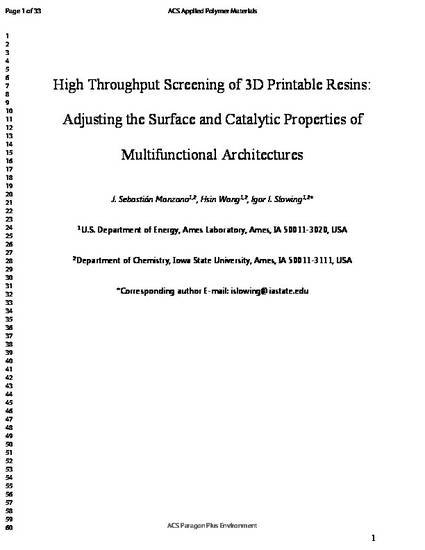
Identification of 3D printable materials is crucial to expand the breadth of physical and chemical properties attainable by additive manufacturing. Stereolithography (SLA), a widespread 3D printing method based on resin photo-polymerization, is ideally suited for exploring a large variety of monomers to produce functional three-dimensional solids of diverse properties. However, for most of the commercially available SLA 3D printers, screening monomers and resin compositions requires large volumes (~150 mL) in each printing cycle, making the process costly and inefficient. Herein, a high throughput block (HTB) adaptor was developed to screen arrays of monomers and resin compositions, consuming lower volumes (< 2 mL) and less time per print (< 1/16 based on a 44 matrix) than using the original hardware. Using this approach, a library of materials with different surface hydrophobicities were 3D printed by including long chain acrylates in the resins. In addition, several metal salts were dissolved in an acrylic acid-based resin, 3D printed and screened as heterogeneous catalysts for the selective aerobic oxidation of benzyl alcohol to benzaldehyde. Cu(II)-based resins produced the most active structures. Combinations of Cu(II) and long chain acrylate monomers were then used to 3D print complex catalytic architectures with varying degrees of hydrophobicity. Linear relationships were observed between 3D printed surface area, surface hydrophobicity and catalyst performance. For a high surface Schwarz P topology ca. 60 % enhancement in the catalytic activity of Cu(II) was attained by replacing the parent resin with one containing hydrophobic isodecyl groups, indicating that the immediate environment of the catalytic site affected its performance. The HTB enables fast screening of resins for 3D printing multifunctional architectures with intrinsic catalytic activity, tunable surface properties, and minimal waste.
Available at: http://works.bepress.com/igor_slowing/66/

This document is the unedited Author’s version of a Submitted Work that was subsequently accepted for publication in ACS Applied Polymer Materials, copyright © American Chemical Society after peer review. To access the final edited and published work see DOI: 10.1021/acsapm.9b00598. Posted with permission.